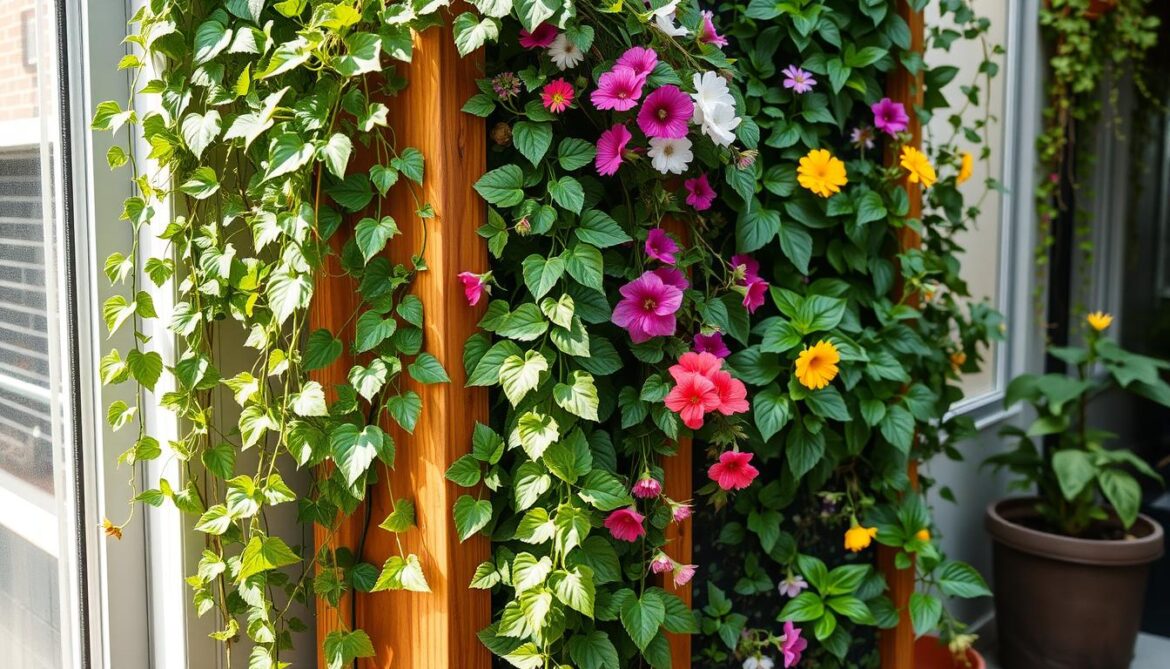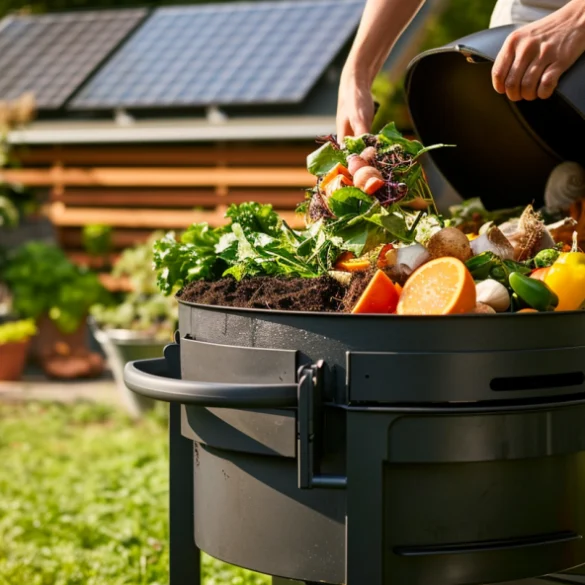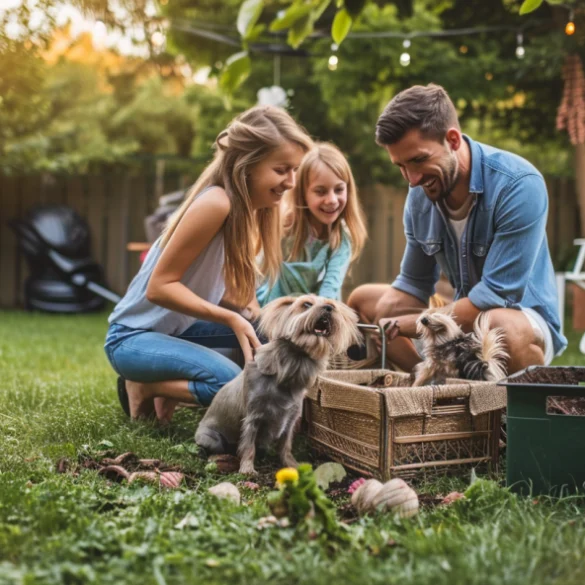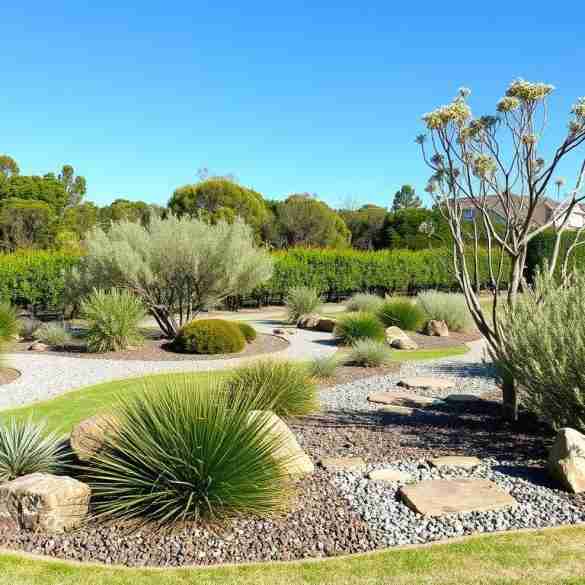Do you dream of a lush garden but find yourself limited by a tiny balcony or windowsill? I felt the same frustration living in my downtown apartment until discovering the transformative power of growing upward instead of outward. The joy of harvesting fresh herbs from my kitchen wall still amazes me every morning.
Small space gardening doesn’t mean small results. By thinking vertically, you can create thriving plant havens in the most unexpected places—from bathroom walls to kitchen windows. These space-saving solutions bring nature into urban environments while reducing your carbon footprint.
In this guide, we’ll explore seven creative DIY solutions that repurpose everyday items into beautiful growing spaces. Each project costs under $30 and requires minimal tools, making sustainable living accessible regardless of your experience level or budget.
Whether you’re a city dweller with just a windowsill or a homeowner looking to add visual interest to your patio, these innovative gardening approaches offer practical ways to grow more food and flowers in less space. Ready to transform your limited area into a thriving green sanctuary?
Key Takeaways
- Create thriving gardens in limited spaces using vertical and overhead techniques
- Complete all projects for under $30 using mostly upcycled materials
- Suitable for beginners and experienced gardeners alike
- Maximize growing space in urban environments and small living quarters
- Contribute to sustainable living through practical, accessible gardening solutions
- Transform ordinary household items into functional growing spaces
Shoe Organizer Vertical Herb Garden
Looking for a creative way to grow herbs in small spaces? A hanging shoe organizer garden is a great DIY idea. It turns an ordinary item into a vertical herb garden that uses your wall space well. With little money and easy setup, you can have a wall of herbs that’s both useful and looks good.
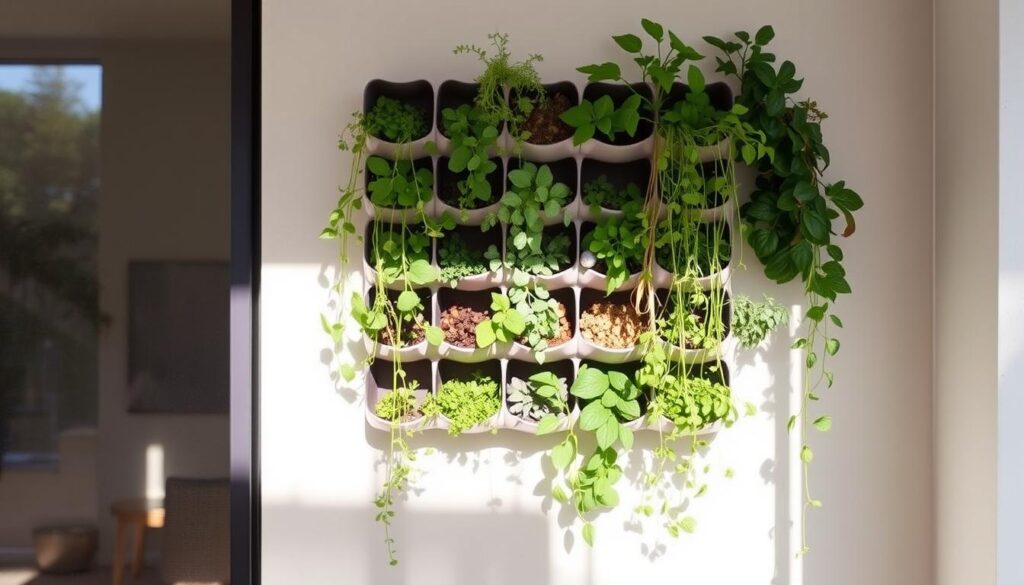
This garden costs $15-25 to make and has 20-24 pockets. It’s perfect for kitchen walls, balconies, or fences. It puts fresh herbs right where you need them, using space that’s usually empty.
Materials List and Sustainable Alternatives
To make your vertical herb garden, you’ll need a few things:
- Hanging shoe organizer (canvas or fabric preferred)
- Lightweight potting soil mix
- Herb seedlings or seeds
- Wall anchors or hooks for mounting
- Scissors or utility knife
- Optional: plastic liner or garbage bags for extra waterproofing
For an eco-friendly gardening approach, reuse an old shoe organizer. Second-hand stores often have them cheap. If buying new, choose natural fibers like cotton canvas for growing food.
Choose durable, non-toxic materials for your organizer since you’ll be growing food. Organic cotton or hemp are the best choices, though they might cost more. They’re worth it for years of herb growth and less environmental harm.
Preparing Your Shoe Organizer for Planting
Before adding soil and plants, prepare your organizer for weight and moisture. Each pocket will hold 2-3 cups of soil, making it heavy when full.
Start by strengthening the hanging loops with extra stitching or grommets if you have them. This stops the pockets from tearing. Use wall anchors rated for 30-40 pounds to keep your garden on the wall.
Drainage is key for small-space gardening. Make small (¼ inch) cuts in the bottom corners of each pocket for drainage. To protect your wall, consider lining each pocket with landscape fabric or placing a plastic tray under the organizer.
For indoor setups, hang your organizer in a bathtub or shower when watering. Then, return it to its spot once the water has drained.
Best Herbs for Vertical Pocket Growing
The 3-4 inch depth of shoe organizer pockets is great for herbs with shallow roots. Choose these top herbs for your DIY gardening project:
- Basil (like ‘Spicy Globe’ or ‘Greek Dwarf’) – Expect 1-2 cups of leaves per month per pocket
- Thyme (all varieties work well) – Provides continuous harvesting of 2-3 tablespoons weekly
- Mint (in individual pockets to prevent spreading) – Yields 1-2 cups monthly
- Chives (regular or garlic varieties) – Produces 3-4 tablespoons of cuttings weekly
- Oregano (compact varieties) – Offers 2-3 tablespoons of fresh leaves weekly
- Cilantro (slow-bolt varieties) – Yields 1 cup every 3-4 weeks before needing replanting
Plant herbs based on their light needs. Sun-lovers like basil and thyme go in top rows. Shade-tolerant herbs like mint and parsley do well in lower pockets.
For ongoing harvests, plant multiple pockets of herbs or stagger your plantings. This way, new growth is always ready as you harvest.
Proper Soil Mixture for Fabric Pockets
The confined space of shoe organizer pockets needs a special soil mix. Standard garden soil is too heavy and dense for this small-space gardening use.
Create the ideal growing medium with this ratio:
- 50% lightweight potting mix (preferably organic)
- 30% coco coir or peat moss (coco coir is the more sustainable gardening choice)
- 20% perlite or vermiculite for drainage
This mix prevents waterlogging while keeping enough moisture. Add 1 tablespoon of slow-release organic fertilizer per pocket for 4-6 weeks of nutrition.
Leave about ½ inch of space at the top of each pocket to prevent soil spills. Firm the soil gently around plant roots without compacting it too much.
With the right preparation and care, your shoe organizer herb garden will give you fresh flavors. It shows how sustainable gardening methods can turn everyday items into growing spaces. This DIY gardening project proves anyone can grow herbs, no matter the space or experience.
Recycled Plastic Bottle Hanging Planters
Turning plastic bottles into hanging planters is a great way to garden sustainably. It’s a creative way to use space and make your home greener. Plus, it’s free and helps the environment by reducing waste.
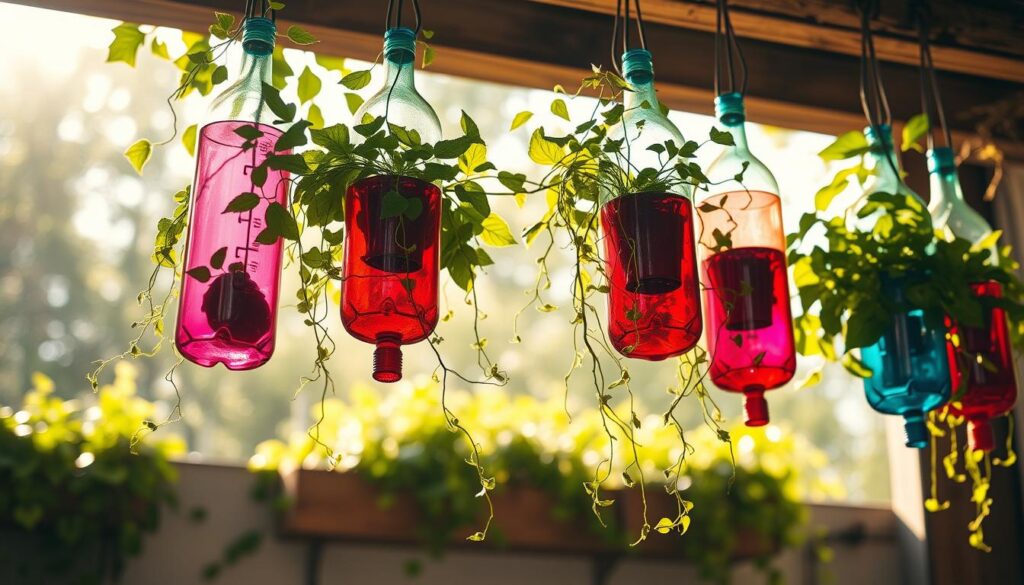
Selecting and Preparing Bottles for Safety
Choosing the right plastic bottles is key for safe gardening. Look for 1-2 liter bottles that are light and big enough for plants. Water and soda bottles work best.
Check the recycling number on the bottle. Numbers 1 and 2 are safe for food and plants. Avoid number 7 bottles, as they might have harmful chemicals.
Clean the bottles well before use. Soak off labels with baking soda and water. For tough residue, try vinegar and water. Dry them completely before cutting.
Cutting Techniques for Different Plant Styles
How you cut the bottle affects the plants it can hold. For plants like ivy, cut a basket shape. Use scissors or a knife to make a 3″ x 5″ opening in the side.
For deeper roots, like herbs, cut the bottle vertically. Remove the top third to make a cup. You can also make a water reservoir by flipping the neck inside the base.
Be careful when cutting plastic. Score lightly first and then cut gently. Sand the edges to prevent cuts. Heat the tool a bit to make cutting easier.
Rope Selection and Sustainable Hanging Methods
The right rope makes your bottle garden look good and work well. Choose natural fibers like jute or hemp for a green touch. They’re also strong and durable.
Make sure your rope can hold the weight of the planter. A full planter weighs 2-3 pounds. Use ropes that can handle double that weight. Thicker ropes are better for distributing weight evenly.
Here are three good knots for hanging bottles:
- Simple loop and knot – fastest method, ideal for lightweight herbs
- Three-point suspension – provides better balance for irregularly shaped bottles
- Adjustable macramé hanger – allows for height customization and adds decorative appeal
For the adjustable macramé, cut four 6-foot ropes. Tie them at the top and hang the bottle in the center. Make a diamond pattern and tie the ropes together at the bottom for stability.
Plant Recommendations for Bottle Environments
Some plants do better in bottle gardens than others. Look for plants with shallow roots and don’t need much water. This makes them perfect for bottle gardens.
| Plant Type | Recommended Varieties | Growing Requirements | Special Considerations |
|---|---|---|---|
| Trailing Plants | String of Pearls, Pothos, English Ivy | Indirect light, moderate water | Use horizontal cut bottles; trim regularly |
| Herbs | Mint, Thyme, Basil, Oregano | 6+ hours sunlight, well-draining soil | Harvest frequently to prevent outgrowing |
| Succulents | Burro’s Tail, String of Buttons | Bright light, minimal water | Add perlite to soil for drainage |
| Flowering Plants | Calibrachoa, Lobelia, Alyssum | Full sun, regular feeding | Choose compact varieties for bottle spaces |
Use a light potting mix with perlite or vermiculite for better drainage. Bottle planters need nutrients often, so use a weak fertilizer every 2-3 weeks.
Think about the weather when you plant. Bottle planters can get hot in the sun. Place them in morning sun and shade in the afternoon. Bring them inside if it gets too cold.
Plastic bottle planters last 1-3 years in the sun. They’re great for annual plants or seedlings. When they’re done, recycle them to keep gardening green.
Gutter Garden Installation
Turning rain gutters into vertical gardens is a smart way to grow food in small spaces. It’s a creative way to use old materials for growing plants. You can make a vertical farm on your wall with just a little effort and some basic tools.
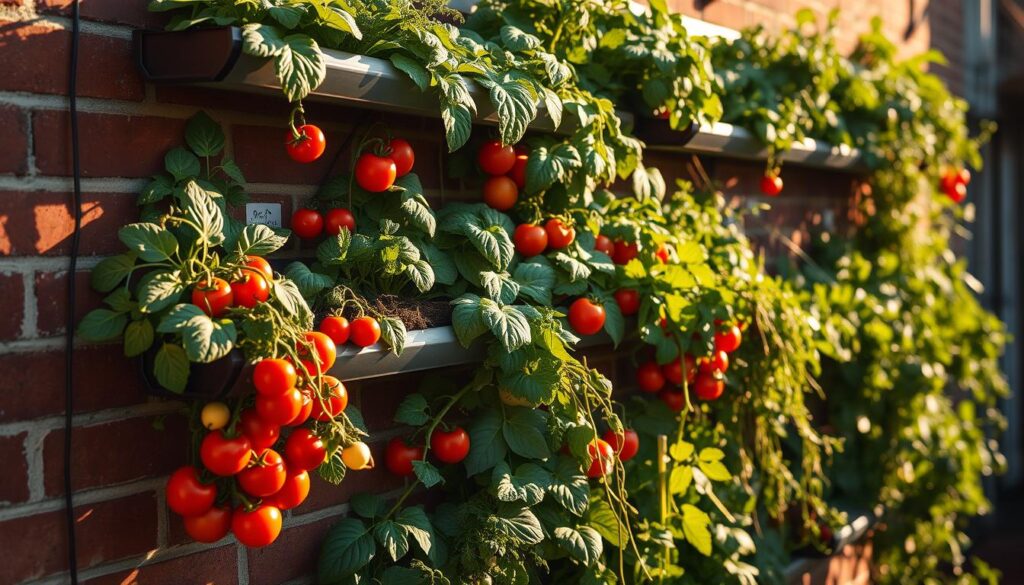
Sourcing Reclaimed Rain Gutters
When starting your gutter garden, you can buy new gutters or find old ones. New vinyl gutters cost about $8-12 for every 10 feet. This makes them a budget-friendly choice for many gardeners.
But, finding old gutters is even better for the planet. You can get them for free from construction sites or when neighbors are redoing their homes. Look in local ads, construction dumpsters, or community groups for these materials.
Before using old gutters, check them first. Here’s what to look for:
- Look for cracks, holes, or warping that might affect water retention
- Check for lead paint (common before 1978) with a lead test kit
- Examine end caps and connection points for integrity
- Look for UV damage that might make the material brittle
After finding good gutters, clean them well. Mix white vinegar and water to clean them. Use a stiff brush to remove dirt and algae. Rinse well and let them dry before starting your project.
Securing Gutters to Various Wall Types
How well your garden grows depends on how you install it. Different walls need different ways to attach gutters. This keeps your garden steady as plants grow and soil gets heavier.
For wooden fences or siding, use galvanized lag screws. On masonry walls, use masonry anchors or concrete screws. For vinyl siding, use special hooks that won’t harm your home.
It’s important to space brackets right. Put them every 16-24 inches to hold the weight of soil and plants. This stops sagging that can hurt your vertical farming setup.
Here are the tools you’ll need:
- Drill with the right bits for your wall
- Level for the right drainage angle
- Measuring tape and pencil for marking
- Screwdriver or socket wrench
- Hacksaw for cutting gutters
Mount your gutters with a slight slope. This helps water flow down and prevents pooling. A ¼ inch drop per foot is a good slope.
Creating Proper Drainage Systems
Good drainage is key for any container gardening system, like gutter gardens. Without it, plants can get root rot and other problems.
Drill ¼-inch holes every 6 inches on the bottom of each gutter. Cover these holes with mesh or landscape fabric. This lets water through while keeping soil in place.
Consider a collection system under your lowest gutter. This can catch runoff water for your garden. A rain barrel can collect this water.
For systems with more than one tier, make sure water flows from top to bottom. This creates a natural flow of water and saves water in your garden.
Soil Depth Requirements for Different Vegetables
Choosing the right plants and soil is important in gutter gardens. Different plants need different amounts of soil. This affects how well they grow in your garden.
For plants like lettuce and herbs, 4-5 inches of soil is enough. Bush beans and compact peppers need 5-6 inches. Radishes and small carrots need 6-8 inches.
Make a special soil mix for your garden. Use:
- 50% high-quality potting soil
- 30% coconut coir or peat moss for water
- 20% perlite or vermiculite for air and water
This mix keeps the right amount of moisture and air for your plants. Add a slow-release fertilizer at planting time for nutrients all season.
| Plant Type | Soil Depth Required | Spacing Between Plants | Harvest Timeline |
|---|---|---|---|
| Lettuce & Greens | 4-5 inches | 6-8 inches | 30-45 days |
| Herbs (Basil, Cilantro) | 4-5 inches | 6-10 inches | Ongoing harvest |
| Bush Beans | 5-6 inches | 4-6 inches | 50-60 days |
| Radishes | 6 inches | 2-3 inches | 21-30 days |
| Small Carrots | 6-8 inches | 2-3 inches | 60-70 days |
A three-tier gutter system can grow a lot of food in a small space. It can produce 30-40 heads of lettuce, 15-20 bunches of herbs, or 8-10 pounds of bush beans. It’s a great way for city gardeners to grow food.
Plan your planting calendar to keep harvesting all season. Start with cool-season crops in spring, then switch to warm-season plants in summer. Go back to cool-season crops in fall for the most from your DIY garden project.
Pallet Wall Garden Construction
Pallet wall gardens are a great DIY project that’s both affordable and versatile. They turn unused space into beautiful gardens, adding to your home’s look. With the right steps, a wooden pallet can become a stunning vertical garden.
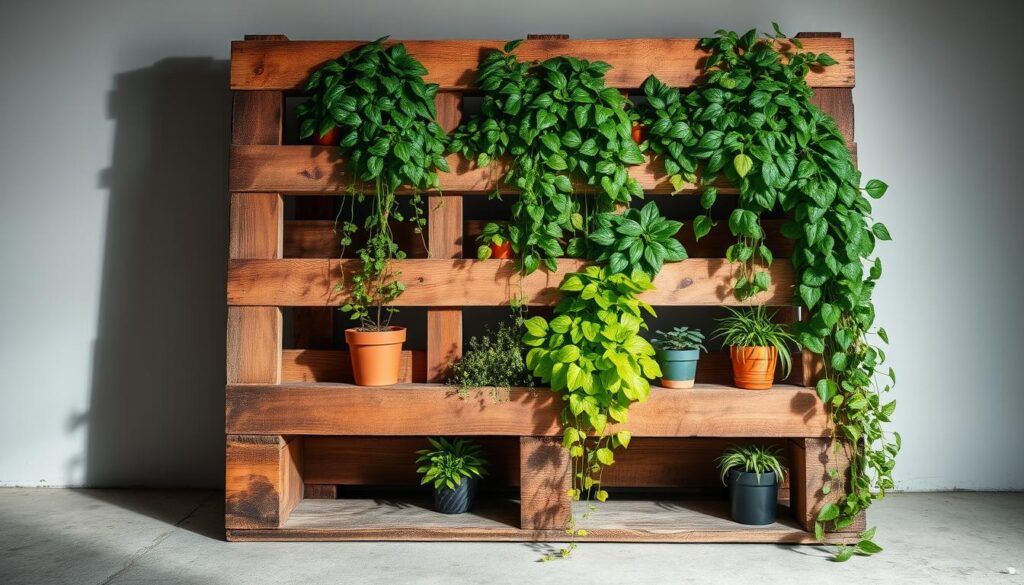
Finding and Selecting Safe Pallets for Gardening
Not all pallets are safe for gardening. It’s key to pick one that’s been treated safely. This ensures your plants and family stay healthy.
Look for pallets with stamps showing they were heat-treated. Heat-treated (HT) pallets are safe because they were dried in a kiln, not treated with chemicals. Avoid pallets marked “MB,” as they were treated with a toxic fumigant.
Check the pallet’s structure and cleanliness too. Here’s a guide to help you choose:
- Check for the HT stamp (heat-treated)
- Inspect for stains, spills, or unusual odors that might indicate chemical contamination
- Examine for structural damage, loose boards, or protruding nails
- Choose pallets made from lighter-colored woods, which are typically less treated
- Select pallets with minimal dirt and no visible mold or fungus
Don’t use pallets with chemical smells, oil stains, or unknown substances. If unsure, it’s better to avoid it. Your plants and family’s health are important.
Pallet Preparation and Toxin Removal Steps
After picking a safe pallet, clean and prepare it well before planting. Start by checking its structure and fixing any loose parts.
Use a mix of white vinegar and water to clean it. This natural solution kills germs without harsh chemicals. Follow these steps:
- Brush away loose dirt and debris with a stiff brush
- Spray the entire pallet with the vinegar solution, scrubbing thoroughly
- Rinse with clean water and allow to dry completely (minimum 48 hours) in direct sunlight
- Sand rough edges to prevent splinters and create a more finished appearance
Next, make planting pockets in the pallet. You can use the existing slats or add dividers for more space. This lets you plant more and makes your garden look great.
Vertical Installation Methods for Different Walls
Installing your pallet garden right is important. A full pallet can be heavy, so choose the right method for your wall. This keeps your garden safe and looking good.
Here’s what to use for different walls:
- Wood siding or studs: 3-inch lag screws driven directly into studs
- Brick or concrete: Masonry anchors with a minimum 50-pound weight rating per anchor
- Drywall: Toggle bolts placed at least 16 inches apart, ensuring connection to studs whenever possible
Make sure there’s a 2-inch gap between the pallet and the wall. This helps with air flow and prevents damage. For outdoor use, add a weather-resistant backing to protect your home.
Irrigation Solutions for Multi-Level Growing
Watering vertical gardens can be tricky. Water flows down, leaving top plants dry and bottom ones wet. A good irrigation system helps solve this problem.
Here are some watering options:
| Irrigation Method | Cost Range | Complexity | Best For |
|---|---|---|---|
| Hand watering | $0 | Low | Small gardens, indoor installations |
| DIY drip system | $25-30 | Medium | Most pallet gardens |
| Timer-controlled system | $50-75 | High | Large installations, busy gardeners |
For a DIY drip system, use 1/4-inch tubing with adjustable emitters. Place the main line at the top and emitters where needed. Add a tray at the bottom to catch excess water.
Choose plants that fit your garden’s layout. Use trailing plants for the bottom and upright ones for the middle and top. This makes your garden look good and works well with different plants.
With the right steps, your pallet garden will be a beautiful feature. It will make your space better and support sustainable living.
Macramé Plant Hanger Projects
Making your own macramé plant hangers is a fun way to add beauty to your space. It’s a great way to save room for plants. These hangers are not just pretty; they also help plants grow better by improving air and light.
With a bit of practice, you can make your own plant holders for less than buying them. Macramé is flexible, fitting any space from windows to porches. It’s perfect for city gardeners.
Beginner-Friendly Knot Techniques
Macramé might look hard at first, but it’s based on just four simple knots. Learning these knots lets you make any hanger design.
- Square Knot – The workhorse of macramé, creating flat, sturdy sections
- Half-Hitch Knot – Perfect for creating spiral patterns and texture
- Spiral Knot – Creates a twisted, rope-like appearance
- Gathering Knot – Used to bundle cords together at transition points
Start with a simple design using 4-6 strands of cord, each 8-10 feet long. This lets you make a basic hanger and still have room for mistakes. Your first project should take under two hours once you understand the basic technique.
Try this beginner-friendly pattern: Start with four 8-foot cords folded in half and attached to a ring with a larks head knot. Create a 2-inch section of alternating square knots, followed by a 3-inch gap. Add another section of square knots, then split the cords into four groups to form the basket using gathering knots at the bottom.
I was intimidated by macramé at first, but after learning just two basic knots, I created three plant hangers in a single weekend. Now my apartment has this gorgeous vertical garden that takes up zero floor space!
Sustainable Cord and Rope Material Options
The right material for your macramé projects affects both looks and function. Choosing eco-friendly materials is key. Natural fibers have different benefits than synthetic ones, each suited for different plants.
| Material | Weight Capacity | Durability | Cost per Project | Environmental Impact |
|---|---|---|---|---|
| Cotton Cord | 5-15 lbs | 2-3 years | $5-8 | Biodegradable, high water usage |
| Jute Rope | 10-20 lbs | 1-2 years | $3-6 | Highly sustainable, biodegradable |
| Hemp Cord | 15-25 lbs | 3-4 years | $8-12 | Low environmental impact, biodegradable |
| Recycled T-shirt Yarn | 8-12 lbs | 2-3 years | $0-4 | Upcycled, reduces textile waste |
| Recycled Plastic Rope | 20-30 lbs | 4-5 years | $6-10 | Diverts plastic waste, not biodegradable |
For humid places like bathrooms, synthetic or hemp cords are better. But in dry areas with indirect light, cotton is best. It comes in many colors and is easy for beginners.
Handmade hangers save money. They cost $5-15 in materials, compared to $30-60 for store-bought ones. You can also customize them to fit your space and plants perfectly.
Weight Consideration for Different Planter Types
Choosing the right hanger for your plants is crucial. Different plants and pots have different weights. Your hanger must support these weights safely.
Lightweight plants in plastic pots need a simple hanger with 3mm cotton cord. Medium-weight plants require thicker cord and more support. Heavy pots or plants need 6mm cord and strong knots.
Test your hanger before using it. Hang it with weights equal to your plant’s weight. Let it hang for 24 hours to check for any issues. This prevents accidents and damage.
For heavier plants, add a weight-bearing ring at the bottom. This spreads the weight evenly, making your hanger more stable.
Multi-Plant Vertical Hanging Systems
Once you’re good at making single-plant hangers, try multi-tier systems. These systems can hold 3-5 plants, making your space more efficient.
Arrange plants by light needs, with sun lovers at the top. This mimics natural growth and uses light well.
For ceiling mounting, choose the right hardware for your ceiling and the weight of your plants:
- Drywall ceilings: Use toggle bolts rated for 30-50 pounds
- Wood beams or joists: Screw-in hooks rated for 50+ pounds
- Concrete ceilings: Use masonry anchors with appropriate weight ratings
Keep your hangers clean to make them last longer. Dust can be vacuumed gently. For deeper cleaning, wash them in mild soap and let them dry before putting plants back.
To refresh old hangers, dye them with plant-based colors or add beads. Small repairs can be made with reinforcement knots.
Creating your own macramé plant hangers turns gardening into an art form. These pieces not only beautify your space but also connect you to a long tradition while supporting sustainability.
Window Frame Vertical Succulent Garden
Turn old window frames into beautiful living walls with this creative project. These frames are perfect for showing off succulents in a unique, space-saving way. They look great indoors and outdoors.
Preparing Old Windows for Planting Surfaces
Find window frames at architectural salvage stores or from renovation projects. Prices vary from $0 to $25, depending on the condition. Make sure the frames are sturdy and test for lead paint with a kit.
Remove old paint with a citrus-based stripper. Then, seal the wood with linseed oil. This keeps the wood safe for plants and keeps the old look.
Creating Shallow Planting Pockets for Succulents
Attach 1/4-inch galvanized mesh to the back of the frame with staples. Then, add 2-3 layers of landscape fabric over the mesh. This makes pockets for planting and lets water drain.
Use a mix of potting soil, perlite, and coarse sand for the soil. Plant 1-2 succulents per square inch. Arrange them for the best look.
Mounting Techniques for Indoor and Outdoor Display
A 24″ x 36″ window garden weighs 15-20 pounds. Choose the right hardware for your wall. For indoor use, removable picture hangers work well.
For outdoor use, use galvanized screws into wall studs. Always put a moisture barrier between the garden and indoor surfaces to avoid water damage.
Seasonal Care for Framed Succulent Gardens
In USDA zones 9 and above, cover your garden in heavy rain with an overhang. Mist indoor gardens weekly in summer and monthly in winter. Outdoor gardens might not need extra water in rainy seasons.
Rotate indoor frames every three months for even growth. Trim plants to keep your garden looking neat and compact.

